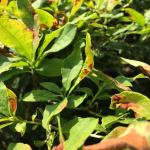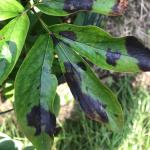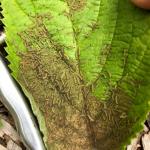UMass Extension's Landscape Message is an educational newsletter intended to inform and guide Massachusetts Green Industry professionals in the management of our collective landscape. Detailed reports from scouts and Extension specialists on growing conditions, pest activity, and cultural practices for the management of woody ornamentals, trees, and turf are regular features. The following issue has been updated to provide timely management information and the latest regional news and environmental data.
To read individual sections of the message, click on the section headings below to expand the content:
Scouting Information by Region
Environmental Data
The following data was collected on or about July 10, 2019. Total accumulated growing degree days (GDD) represent the heating units above a 50° F baseline temperature collected via our instruments for the 2019 calendar year. This information is intended for use as a guide for monitoring the developmental stages of pests in your location and planning management strategies accordingly.
|
MA Region/Location |
GDD |
Soil Temp |
Precipitation |
Time/Date of Readings |
||
|
2-Week Gain |
2019 Total |
Sun |
Shade |
|||
|
CAPE |
293 |
860 |
73 |
68 |
0.08 |
12:00 PM 7/10 |
|
SOUTHEAST |
324 |
973.5 |
71 |
64 |
0.03 |
8:45 AM 7/10 |
|
NORTH SHORE |
312 |
947.5 |
68 |
64 |
0.97 |
10:30 AM 7/10 |
|
EAST |
335 |
1050 |
77 |
71 |
2.47 |
5:00 PM 7/10 |
|
METRO |
318.5 |
982.5 |
69 |
64 |
0.50 |
6:00 AM 7/10 |
|
CENTRAL |
333.5 |
1028.5 |
68 |
63 |
1.10 |
8:00 AM 7/10 |
|
PIONEER VALLEY |
297.5 |
1017.5 |
78 |
67 |
0.55 |
3:00 PM 7/9 |
|
BERKSHIRES |
124.5 |
925.5 |
69 |
68 |
0.38 |
7:15 AM 7/9 |
|
AVERAGE |
313 |
973 |
72 |
66 |
0.76 |
- |
n/a = information not available
For both a map and a list of towns currently under water use restrictions, see: https://www.mass.gov/service-details/outdoor-water-use-restrictions-for-cities-towns-and-golf-courses
Phenology
| Indicator Plants - Stages of Flowering (BEGIN, BEGIN/FULL, FULL, FULL/END, END) | ||||||||
|---|---|---|---|---|---|---|---|---|
| PLANT NAME (Botanic/Common) | CAPE | S.E. | N.S. | EAST | METRO W. | CENT. | P.V. | BERK. |
|
Buddleia davidii (butterfly bush) |
Begin |
* |
Begin/Full |
* |
* |
* |
Begin |
* |
|
Campsis radicans (trumpet vine) |
Begin |
* |
* |
Begin |
Begin |
* |
Begin |
* |
|
Koelreuteria paniculata (goldenrain tree) |
Begin |
* |
Begin |
Begin |
* |
* |
Begin |
* |
|
Oxydendron arboreum (sourwood) |
Begin |
Begin/Full |
Begin |
Begin |
Begin/Full |
Begin |
Begin/Full |
* |
|
Tilia cordata (littleleaf linden) |
Begin/Full |
Full |
Full |
Full |
Full |
Begin/Full |
Full |
Full |
|
Hydrangea macrophylla (bigleaf Hydrangea) |
Begin |
Begin/Full |
Begin/Full |
Full |
Full |
Full |
Full |
* |
|
Hydrangea arborescens (smooth Hydrangea) |
Begin/Full |
Full |
Full |
Full |
Full |
Begin/Full |
Full |
Full |
|
Rhus typhina (staghorn sumac) |
Full |
Full |
Full |
Full |
Full |
Full/End |
Full |
Full |
|
Sambucus canadensis (American elderberry) |
Full |
Full |
Full |
Full |
Full |
Full |
Full/End |
Full |
|
Itea virginica (Virginia sweetspire) |
Full/End |
Full |
Full/End |
Full |
* |
Full/End |
Full/End |
Full |
| * = no activity to report/information not available | ||||||||
Regional Notes
Cape Cod Region (Barnstable)
General Conditions: The average temperature for the period from June 26 thru July 10 was approximately 71˚F with a high of 86˚F on July 4 and a low of 55˚F on July 8. The period has been dominated by sunny weather with highs mainly in the high 70s and/or low 80s, and nighttime temperatures in the mid to upper 60s. Overall, great conditions for the beach and holiday festivities. There was little to no precipitation in Barnstable as less than a tenth of an inch was recorded on July 6. This is the time of year in which a rain gauge is a valuable tool because precipitation events are spottier and amounts variable. Topsoil moisture is short, subsoil moisture is adequate.
Pests/Problems: Lecanium scale eggs have begun to hatch. However, the tiny scales have yet to migrate to leaves to begin feeding and still remain protected under the hardened hemispherical bodies of the adults. Foliar treatments targeting crawlers should be delayed until scales emerge from underneath the adults and migrate to feed on the undersides of the leaves. Lecanium scale populations are heaviest on oak and in most situations are unlikely to require management unless the trees are of high value, stressed or where sooty mold may cause issues. Asiatic, Oriental and Japanese beetles have all begun to emerge and can be seen damaging various hosts. Oriental beetle tends to be the more abundant species in our area. Other insects or insect damage observed during the period includes Hibiscus sawfly on Hibiscus, rose slug sawfly damage on rose, azalea lacebug on azalea, cottony maple scale on maple, and two spotted spidermite on numerous plants. Disease symptoms and signs observed over the period include boxwood blight on boxwood, downy mildew on Cleome, severe powdery mildew on ninebark, powdery mildew on the usuals (Phlox, Monarda, lilac, etc), Cercospora leaf spot on Hydrangea, and black spot on rose. Red thread activity is subsiding with the hot, drier conditions. Rabbits continue to be abundant. Deerflies, greenhead flies, and mosquitoes are active. Weeds in bloom include black medic (Medicago lupulina), white clover (Trifolium repens), fleabane (Erigeron annuus), and narrowleaf plantain (Plantago lanceolata).
Southeast Region (New Bedford)
There are no regional notes this week.
North Shore (Beverly)
General Conditions: This reporting period we experienced real summer weather. It was hot and humid with day temperatures in the mid to high 80s. Temperature above 90˚F was recorded only on Saturday, July 6. Although it was hot during the day, night temperatures were mostly in the high 50s to mid-60s. Approximately 0.97 inches of rainfall was received at Long Hill, Beverly during this reporting period. Most of the rain was received on June 29 and July 6. Because of the rains and warm temperatures, turf on lawns is growing fast and requiring regular mowing. Woody plants seen in bloom include: Virginia sweetspire (Itea virginica), smoke bush (Cotinus coggygria), sweet azalea (Rhododendron arborescens), Indigofera (Indigofera amblyantha), oakleaf Hydrangea (Hydrangea quercifolia), big leaf Hydrangea (Hydrangea macrophylla), smooth leaf Hydrangea (Hydrangea arborescens), Japanese Hydrangea vine (Schizophragma hydrangeoides), summer blooming Spiraea (Spiraea japonica), butterfly bush (Buddleja davidii),staghorn sumac (Rhus typhina), ‘Winterthur’ smooth witherod (Viburnum nudum), and littleleaf linden (Tilia cordata). Herbaceous plants seen in bloom include: summer flowering roses (Rosa spp.), Clematis vines (Clematis paniculata), spiderwort (Tradescantia spp.), Persicaria (Persicaria polymorpha), goat’s beard (Aruncus dioicus),Martagon or Turk’s cap lily (Lilium martagon),water lily (Nymphaea odorata), ox-eye daisy (Leucanthemum vulgare), daylilies (Hemerocallis spp.), Hostas, Astilbes and an assortment of annuals.
Pests/Problems: Marginal leaf scorch was observed on Japanese Stewartia. Cedar-hawthorn rust (Gymnosporangium globosum) was observed on fruits of single seed hawthorn (Crataegus monogyna). Phyllosticta leaf blotch on witch hazel (Hamamelis intermedia) continues to get worse. Irregular brown leaf spots (possibly caused by Cercospora handelii) were observed on sweet azalea (Rhododendron arborescens). If you have disease symptoms on your plants, send samples to the plant diagnostic lab https://ag.umass.edu/services/plant-diagnostics-laboratory for correct diagnosis of the disease and recommendations for control. Leaf rolling caterpillars were also observed on summersweet Clethra (Clethra alnifolia). Weeds continue to thrive in the landscape. Poison ivy is also thriving so take caution when walking or working in the woods. Remember also that ticks and mosquitoes are still very active. Take measures to protect yourself while working outdoors.
East Region (Boston)
General Conditions: Summer arrived with some beautiful, warm, sunny days, including several on the humid side. High temperatures ranged from 76˚- 93˚F, averaging 85˚F. Low temperatures ranged from 59˚- 71˚F, averaging 63˚F. We gained 335.0 GDDs for a total of 1050 GDDs for the year. We experienced four rain events over the past two weeks totaling 2.47 inches including 1.23 inches on July 6 and 1.14 inches on June 29. There seems to be something flowering everywhere throughout the landscape. A few of the many plants in bloom include: Hemerocalis spp. (daylilly), Platycodon grandiflora (balloon flower), Poliothyrsis sinensis (Chinese pearlbloom) and Silphium perfoliatum (cup plant). Several species of Tilia (linden) are all in some stage of bloom. There is a very distinct smell as you approach a group of linden in flower.
Pests/Problems: Crabgrass (Digitaria spp.) is rapidly filling in any vacancies in turf and unmulched beds. Many landscape weeds are flowering: Asiatic dayflower (Commelina communis), hairy Galinsoga (Galinsoga ciliata), pokeweed (Phytolacca americana), bittersweet nightshade (Solanum dulcamara) and black nightshade (Solanum nigrum) to name but a few. Viburnum leaf beetle (Pyrrhalta viburni) adults have begun the second round of defoliating susceptible Viburnum. Hibiscus sawfly (Atomacera decepta) caterpillars are skeletonizing hardy Hibiscus foliage. Cottony Camellia scale (Pulvinaria floccifera) have been prolific on climbing Hydrangea (Hydrangea petiolaris). Slugs and snails continue to feed in the vegetable garden. Despite the rather consistent precipitation, annuals and recent plantings require supplemental irrigation during these hot summer days.
Metro West (Acton)
General Conditions: Summer weather has arrived. It’s been from warm to hot - and humid - the last couple of weeks! On four consecutive days, beginning on July 3rd and ending on July 6th, the high temperatures were recorded in the 90s, with a high of 93°F on July 6th. For June, the historical monthly average precipitation is 3.93” and 4.83” of rain was recorded. For July, the monthly average precipitation is 4.07”. As of the 9th, a mere 0.50” of rain has been recorded. The landscape is lush and colorful with all that is in flower. In some stage of bloom at this time are the following woody plants: Aesculus parviflora (bottlebrush buckeye), Castanea mollissima (Chinese chestnut), Hydrangea arborescens (smooth Hydrangea), H. paniculata (panicle Hydrangea), H. quercifolia (oakleaf Hydrangea), Oxydendron arboreum (sourwood), Ligustrum spp. (privet), Potentilla fruiticosa (Potentilla), Rhododendron spp. (Rhododendron/azalea), Rhus typhina (staghorn sumac), Rosa spp. (rose), R. rugosa (rose), R. 'Knockout' (knockout family of roses), Rubus spp. (blackberry, bramble, raspberry), Sambucus canadensis (elderberry), Spirea japonica 'Alpina' (Daphne Spirea), Spirea spp. (bridal wreath), Stewartia psuedocamellia (Japanese Stewartia),and Tilia cordata (littleleaf linden). Woody vines in bloom are: Campsis radicans (trumpet vine) and Clematis spp. (Clematis). Contributing even more color and interest to the landscape are some flowering herbaceous plants including: Achillea millefolium (yarrow), Aegopodium podagraria (bishop’s weed), Aruncus aethusifolius (dwarf goat's beard), A. dioicus (goat’s beard), Asclepias syriaca (common milkweed), A. tuberosa (butterfly weed), Astilbe spp. (false Spirea), Chrysogonum virginianum (green and gold), Coreopsis spp. (tickseed), Filipendula spp. (meadow sweet), Gaillardia aristata (Indian blanket flower), Geranium sanguineum (bloody cranesbill), Hemerocallis fulva (orange daylily), H. 'Stella D'Oro' (daylily), H. spp. (daylily), Heuchera spp.(coral bells), Hosta spp. (plantain lily), Lamium maculatum (dead nettle), Leucanthemum spp. (shasta daisy), Lychnis coronaria (rose campion), Lysimachia clethroides (gooseneck loosestrife), Monarda didyma (scarlet bee-balm), Nepeta spp. (ornamental catmint), Oenothera macrocarpa (Ozark sundrops), Thermopsis caroliniana (southern lupine), Tradescantia spp. (spiderwort), and Thymus praecox (thyme).
Pests/Problems: I reported above in the general conditions for this area that much is in bloom. This includes several of our aggressive weeds including Phytolacca americana (common pokeweed) and Lythrum salicaria (purple loosestrife). Deer, mosquitoes and ticks are actively feeding.
Central Region (Boylston)
General Conditions: True New England summer weather prevailed for the past week, with temperatures in the high 80’s, high humidity during the day and mid 60’s at night. Many varieties of Yucca, Hosta, Hydrangea and daylily are beginning to or are in the midst of blooming. Our sourwood trees are pushing out flowers getting ready to bloom, while milkweeds and bugbane are in full bloom supplying nectar to a host of native fauna.
Pests/Problems: Asiatic beetles such as Japanese beetle (Popillia japonica) and Oriental beetle (Anomala orientalis) are flourishing right now. Japanese beetles are mating in heavy clusters on ornamentals such as roses and calla lily. Hand removal is the best control method as pheromone traps tend to attract more beetles causing increased damage. Gypsy moth caterpillar has been found deceased in large numbers on pine trunks, an encouraging sign before pupation. Powdery mildew was observed on horse chestnut.
Pioneer Valley Region (Amherst)
General Conditions: As mid-July approaches, we’re deep in the dog days of summer here in the Pioneer Valley. Much has happened since our last report in late June. Independence Day has come and gone and the heat of the searing summer sun is a daily occurrence. Depending on your location in the valley, the lack of rainfall is the biggest concern at this time. June precipitation was well below-average in Hampden County, with many weather stations hovering around 2″ or below. Hampshire County fared somewhat better, with totals over 3″, but still below-average. Franklin County received near average rainfall for the month with totals over 4″ at several stations. In many areas of Hampshire and Hampden Counties, the last meaningful rainfall (>0.5″) occurred on 6/25. We experienced our first heat wave of 2019 during this past reporting period, from 7/3 to 7/6. High temperatures peaked on Saturday, 7/6 when the mercury rose to 95°F in Westfield. In addition, dew points flooded above 70°F, producing a heat index value ≥100°F. It was the swampy, oppressive heat and humidity amalgamation that we thankfully don’t have to deal with very often in New England. By mid-afternoon, a strong band of thunderstorms swept east through the region, bringing locally heavy rains and abundant thunder and lightning. However, rainfall accumulations ranged from minimal (0.3″ in Easthampton) to moderate (0.7″ in New Salem) to overwhelming (>2.5″ in Longmeadow). A large number of trees were brought down in Hampden County as a result of the storm. The National Weather Service confirmed a microburst hit the town on Longmeadow with winds in excess of 70 mph. The resulting cold front pushed the humid air mass out and dew points were far more comfortable on Sunday, 7/7. Low temperatures dipped back into the upper 50s on the mornings of 7/8 and 7/9, giving us a respite from the heat that built the week before. The long-term forecast calls for lots of sun and a chance of thunderstorms but no significant accumulations are expected.
Pests/Problems: Turfgrasses are browning and dying back in Hampshire County due to the lack of rainfall. Marginal browning due to heat scorch is appearing on some trees and shrubs, especially those in exposed areas with compacted soils and surrounding hardscapes that conduct and reflect heat. Surface and subsurface soils are drying so supplemental water is obligatory for newly transplanted trees and shrubs at this time. It’s important to avoid frequent and shallow watering and instead provide a soaking irrigation of the entire root zone at five to seven-day intervals. As of 6/21, there are no municipal water use restrictions in the tri-county region (https://www.mass.gov/service-details/outdoor-water-use-restrictions-for-cities-towns-and-golf-courses). Fall webworm feeding has been observed on Viburnum (see photo) and American elm. Tubakia leaf blotch is beginning to appear on oaks in the region. Disease incidence and severity was very high in 2018 due to the abundant late season rainfall. It will be interesting to see if disease severity is high again in 2019 after the wet conditions in spring. Oriental beetles are actively feeding on a wide array of herbaceous and woody plants and Japanese beetles are now starting to appear as well. While roses are their preferred host, collectively they have a large host range of herbaceous and woody plants. Damage from the honeylocust plant bug can be readily observed on trees at this time. From afar, infested honey locust appear unaffected but close examination reveals the injury to the foliage. Branch flagging, leaf yellowing/browning and premature leaf shedding due to Dutch elm disease is now visible in the landscape. Stunted and blighted new growth on hard pines caused by Diplodia sapinea can be found as well throughout the landscape. The dry weather and heat have helped sycamores that were badly defoliated for much of the early growing season by sycamore anthracnose. The pathogen responsible, Apiognomonia veneta, sporulates prolifically from infected shoots and leaves (see photo). Apple scab continues to cause leaf shedding on shaded crabapples and apples, but for trees in full sun, the dry weather has slowed disease progression.
Berkshire Region (Great Barrington)
General Conditions: The weather during the period from June 26 through July 9 took an abrupt turn to hot, humid, and dry. Though daily temperatures vary from south to north in Berkshire County, the temperatures in mid-County, i.e. Pittsfield, were typically in the 80s, with highs of 88˚F on 7/4 and 7/5, and 89˚F on 7/6. Overnight lows were in the comfortable range of low to mid 50s. Rainfall has been scarce, with only 2 days receiving any measurable precipitation. Total rainfall year-to-date is at the normal level. Soil moisture is moderate with only the surface inch being bone dry. Irrigation may only be needed where new plantings exist and on sites with coarse, rapidly draining soils. Turfgrass growth continues at a moderate rate, showing no signs yet of experiencing any summer dormancy.
Pests/Problems: The first sighting of Japanese beetle occurred on July 5th, just a bit later than usual. The numbers of beetles are still low. A few Asiatic garden beetles have also been observed. Though the numbers of these beetles usually increase through this month, one has to wonder whether the low oxygen levels of water-logged soils last fall influenced their population size, since the beetles overwinter as larvae in the soil. Fall webworm has made an appearance and they were seen feeding on the foliage of blueberry. Imported willow leaf beetles are now in the pupal stage. A few spruce spider mites can still be seen despite the development of hot weather. Deer ticks are in the nymph stage, quite difficult to see, and they are abundant. It is extremely important to use repellents and take all precautions since the occurrence of tick bites is very high. Anthracnose on tulip trees, fire blight on cherry, and botrytis on some herbaceous plants were observed. Reports of winter related damage or death of woody species continue to come in. At one public garden, all of their Buddleia specimens have died. Parrotia persica is another plant which suffered death or considerable dieback.
Regional Scouting Credits
- CAPE COD REGION - Russell Norton, Horticulture and Agriculture Educator with Cape Cod Cooperative Extension, reporting from Barnstable.
- SOUTHEAST REGION - Kristin McCullin, Horticulturist reporting from Haskell Public Gardens, New Bedford.
- NORTH SHORE REGION - Geoffrey Njue, Green Industry Specialist, UMass Extension, reporting from the Long Hill Reservation, Beverly.
- EAST REGION - Kit Ganshaw & Sue Pfeiffer, Horticulturists reporting from the Boston area.
- METRO WEST REGION – Julie Coop, Forester, Massachusetts Department of Conservation & Recreation, reporting from Acton.
- CENTRAL REGION - Mark Richardson, Director of Horticulture reporting from Tower Hill Botanic Garden, Boylston.
- PIONEER VALLEY REGION - Nick Brazee, Plant Pathologist, UMass Extension Plant Diagnostic Lab, reporting from UMass Amherst.
- BERKSHIRE REGION - Ron Kujawski, Horticultural Consultant, reporting from Great Barrington.
Woody Ornamentals
Diseases
Tomography: An Innovative Technique for Assessing Forest Carbon Storage
The following links provide a summary of work by Nicholas Brazee (UMass) and Robert Marra (CT Ag. Exp. Sta.) on the use of sonic and electrical resistance tomography to better detect and quantify internal decay in living trees.
PDF: https://www.scientia.global/wp-content/uploads/Brazee_Marra/Brazee_Marra.pdf
HTML: https://www.scientia.global/tomography-an-innovative-technique-for-assessing-forest-carbon-storage/
Recent pests and pathogens of interest seen in the UMass Extension Plant Diagnostic Lab https://ag.umass.edu/services/plant-diagnostics-laboratory:
Dieback of Eastern White Pine: Pathogens, Pests and a Changing Climate
Eastern white pine (Pinus strobus) is one of the most economically valuable and ecologically important forest trees in the northeast. It is also an abundant landscape tree with numerous cultivars available through the nursery trade. In recent years, white pines in the region have exhibited symptoms of decline, which include: yellowing/browning needles, premature needle shedding, thinning canopies, undersized shoots and needles, resinosis, branch dieback and death. Widespread health issues for white pine first developed in approximately 2009. In the ten years since these problems became apparent, a great deal has been learned and it’s now known that multiple fungal pathogens, an insect pest and a changing climate are responsible. First and most importantly, white pine needle disease (WPND) is primarily responsible for the symptoms that many trees exhibit and is caused by several fungal pathogens. Branch and trunk cankering, caused by Caliciopsis canker, is also as an important component of the decline complex, although disease severity varies by region. Most recently, the eastern white pine bast scale has been identified as an important predisposing agent that helps facilitate Caliciopsis canker. What is particularly interesting about the pathogens and insect pest responsible for white pine decline is that each is known or believed to be native in eastern North America. The widespread distribution of symptomatic trees and lack of a non-native pathogen or insect lead researchers to investigate the role of environmental conditions, which have been altered by a changing climate. What they found was that an increase in temperature and precipitation from May through July has helped to fuel the WPND epidemic. It is believed that the issues facing eastern white pine will only continue but management options do exist to help improve the health and vigor of stressed white pines.
Read more about eastern white pine health issues here:
https://ag.umass.edu/landscape/fact-sheets/dieback-of-eastern-white-pine
Report by Nick Brazee, Plant Pathologist, UMass Extension Plant Diagnostic Lab, UMass Amherst.
Insects
Beneficial insects of interest:
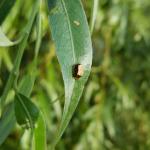 Assassin Bugs: Hemiptera: Reduviidae: This family of true bugs are known as the assassin bugs. As their name might suggest, they are predators. They feed on the immatures and adults of other insect species, including at times other assassin bugs. These insects are often elongated, thin, and have pronounced, long mouthparts used to pierce their prey. Some possess spines, and others have a “wheel” on their back which might look to some like half of a saw blade sunk into their thorax. While assassin bugs can be important predators of pest insects, they alone may not become abundant enough to manage entire pest populations. That said, it is important to recognize them as beneficial insects and to seek to preserve their numbers when making management decisions.
Assassin Bugs: Hemiptera: Reduviidae: This family of true bugs are known as the assassin bugs. As their name might suggest, they are predators. They feed on the immatures and adults of other insect species, including at times other assassin bugs. These insects are often elongated, thin, and have pronounced, long mouthparts used to pierce their prey. Some possess spines, and others have a “wheel” on their back which might look to some like half of a saw blade sunk into their thorax. While assassin bugs can be important predators of pest insects, they alone may not become abundant enough to manage entire pest populations. That said, it is important to recognize them as beneficial insects and to seek to preserve their numbers when making management decisions.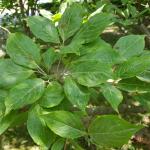
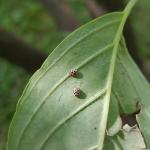 Lady Beetles: Coleoptera: Coccinellidae: Psyllobora spp. It is widely known that many lady beetles (ladybugs, ladybird beetles) are beneficial insects as they may feed on the eggs, immatures, and adult insects of pest species such as certain soft scales, armored scales, mealybugs, whiteflies, mites, and aphids. Perhaps not as widely known, however, is that some species feed on certain fungi, such as the powdery mildews. On 7/10/19, such a lady beetle in the genus Psyllobora (likely P. vigintimaculata or the twenty spotted lady beetle) was easily observed in moderately high numbers on dogwood with a light infestation of powdery mildew in Amherst, MA. Larvae, adults, and pupae were seen. In the literature, this insect has been observed feeding on powdery mildew on at least 26 plant species in 13 different plant families in the landscape. This insect is very tiny, averaging 2.38 mm. in length. Adults are typically white/cream colored with various black spots on their elytra and pronotum which can be used in identification. (However, geographically, other color forms do occur.) Research has suggested that this native insect should be conserved as a natural enemy of powdery mildew, and in some cases can be used as an indicator of early and isolated powdery mildew infection.
Lady Beetles: Coleoptera: Coccinellidae: Psyllobora spp. It is widely known that many lady beetles (ladybugs, ladybird beetles) are beneficial insects as they may feed on the eggs, immatures, and adult insects of pest species such as certain soft scales, armored scales, mealybugs, whiteflies, mites, and aphids. Perhaps not as widely known, however, is that some species feed on certain fungi, such as the powdery mildews. On 7/10/19, such a lady beetle in the genus Psyllobora (likely P. vigintimaculata or the twenty spotted lady beetle) was easily observed in moderately high numbers on dogwood with a light infestation of powdery mildew in Amherst, MA. Larvae, adults, and pupae were seen. In the literature, this insect has been observed feeding on powdery mildew on at least 26 plant species in 13 different plant families in the landscape. This insect is very tiny, averaging 2.38 mm. in length. Adults are typically white/cream colored with various black spots on their elytra and pronotum which can be used in identification. (However, geographically, other color forms do occur.) Research has suggested that this native insect should be conserved as a natural enemy of powdery mildew, and in some cases can be used as an indicator of early and isolated powdery mildew infection.
Woody ornamental (and other) insect and non-insect arthropod pests to consider, a selected few:
- Asian Longhorned Beetle: (Anoplophora glabripennis, ALB) Look for signs of an ALB infestation which include perfectly round exit holes (about the size of a dime), shallow oval or round scars in the bark where a female has chewed an egg site, or sawdust-like frass (excrement) on the ground nearby host trees or caught in between branches. Be advised that other, native insects may create perfectly round exit holes or sawdust-like frass, which can be confused with signs of ALB activity.
The regulated area for Asian longhorned beetle is 110 miles2 encompassing Worcester, Shrewsbury, Boylston, West Boylston, and parts of Holden and Auburn. If you believe you have seen damage caused by this insect, such as exit holes or egg sites, on susceptible host trees like maple, please call the Asian Longhorned Beetle Eradication Program office in Worcester, MA at 508-852-8090 or toll free at 1-866-702-9938.
To report an Asian longhorned beetle find online or compare it to common insect look-alikes, visit: http://massnrc.org/pests/albreport.aspx or https://www.aphis.usda.gov/pests-diseases/alb/report .
- White Spotted Pine Sawyer (WSPS): Monochamus scutellatus adults can emerge throughout July. This is a native insect in Massachusetts and is usually not a pest. Larvae develop in weakened or recently dead conifers, particularly eastern white pine (Pinus strobus). However, the white spotted pine sawyer looks very similar to the invasive Asian Longhorned Beetle, Anoplophora glabripennis, ALB. ALB adults emerge in Massachusetts primarily in July and August. Now is the time to look for the key difference between WSPS and ALB adults, which is a white spot in the top center of the wing covers (the scutellum) on the back of the beetle. White spotted pine sawyer will have this white spot, whereas Asian longhorned beetle will not. Both insects can have other white spots on the rest of their wing covers; however, the difference in the color of the scutellum is a key characteristic. If you find a suspicious insect, report it:http://massnrc.org/pests/albreport.aspx or https://www.aphis.usda.gov/pests-diseases/alb/report .
- Gypsy Moth:(Lymantria dispar) host plants include but are certainly not limited to oak (favored), maple, birch, poplar, elm, witch hazel, and many others. Historically, gypsy moth adults are present at this time in Massachusetts, if they survive. The population in Massachusetts has once again been hit hard by pathogens present in our landscapes (see the previous Landscape Message). Once pupation occurs, the insect will no longer feed for the current season, and management is no longer necessary or feasible. Adult moths do not feed. The adult male gypsy moth is brown with black markings and highly feathered antennae. Adult male gypsy moths can fly. The adult female gypsy moth is white with black markings and straight, threadlike, black antennae. In Massachusetts, female gypsy moths do not fly (in other parts of the world, certain types of gypsy moths have females capable of flight). After the adults mate, the female moths lay the egg masses (tan/brown and spongy) which will overwinter. Collaborators monitoring gypsy moth in MA this year have not seen pupation or adult emergence in the field, but some collected larvae reared for experiments have pupated and one adult male was reported as emerging on 7/9/2019. Last year, on July 10, 2018 at a location monitored in Amherst, MA, female gypsy moths were observed laying their egg masses at this time of year. In 2019, no pupae or adult gypsy moths have yet been observed at a location being monitored in Amherst, MA.
- Asiatic Garden Beetle: Maladera castanea adults are active and are typically most abundant in July and August. These rusty-red colored beetles are bullet-shaped and active at night. They are often attracted to porch lights. They feed on a number of ornamental plants, defoliating leaves by giving the edges a ragged appearance and also feeding on blossoms. Butterfly bush, rose, dahlia, aster, and chrysanthemum can be favored hosts.
- Cottony Taxus Scale: Pulvinaria floccifera, also referred to as the cottony camellia scale, utilizes such hosts as Taxus, Camellia, holly, Hydrangea, Japanese maple, Euonymus, Magnolia, and jasmine, among others. Females have laid the long, narrow, white and fluted egg sac that makes them much more noticeable. Eggs will hatch over an extended period of 6 weeks and crawlers may be treated between 802-1388 GDD’s. This insect can cause the host to appear off-color. They also produce honeydew which promotes sooty mold growth. Dieback is not common with this insect. Target the underside of the foliage. Horticultural oil, neem oil, and insecticidal soaps may be used to manage these soft scales. Reduced risk options help preserve natural enemies.
- Deer Tick/Blacklegged Tick: Check out the archived FREE TickTalk with TickReport webinars available here:https://ag.umass.edu/landscape/education-events/webinars . The next live webinar will be held on October 9, 2019 with Dr. Stephen Rich of the UMass Laboratory of Medical Zoology. Previous webinars including information about deer ticks and associated diseases, American dog ticks and lone star ticks and associated diseases, ticks and personal protection, and updates from the Laboratory of Medical Zoology are archived at the link above.
Deer tick (Ixodes scapularis) nymphs (immatures) are active at this time, and may be encountered now through August. For images of all deer tick life stages, along with an outline of the diseases they carry, visit: http://www.tickencounter.org/tick_identification/deer_tick .
Anyone working in the yard and garden should be aware that there is the potential to encounter deer ticks. The deer tick or blacklegged tick can transmit Lyme disease, human babesiosis, human anaplasmosis, and other diseases. Preventative activities, such as daily tick checks, wearing appropriate clothing, and permethrin treatments for clothing (according to label instructions) can aid in reducing the risk that a tick will become attached to your body. If a tick cannot attach and feed, it will not transmit disease. For more information about personal protective measures, visit: http://www.tickencounter.org/prevention/protect_yourself . For a quick overview of skin repellents available to protect yourself from ticks, visit “Tickology: Skin Repellents” by Larry Dapsis of Cape Cod Cooperative Extension:https://bit.ly/2J8IJBl .
Have you just removed an attached tick from yourself or a loved one with a pair of tweezers? If so, consider sending the tick to the UMass Laboratory of Medical Zoology to be tested for disease causing pathogens. To submit a tick to be tested, visit: https://www.tickreport.com/ and click on the blue “Order a TickReport” button. Results are typically available within 3 business days, or less. By the time you make an appointment with your physician following the tick attachment, you may have the results back from TickReport to bring to your physician to aid in a conversation about risk.
The UMass Laboratory of Medical Zoology does not give medical advice, nor are the results of their tests diagnostic of human disease. Transmission of a pathogen from the tick to you is dependent upon how long the tick had been feeding, and each pathogen has its own transmission time. TickReport is an excellent measure of exposure risk for the tick (or ticks) that you send in to be tested. Feel free to print out and share your TickReport with your healthcare provider.
- Emerald Ash Borer: (Agrilus planipennis, EAB) Three additional communities have had emerald ash borer confirmed by the Massachusetts Department of Conservation and Recreation. This brings the 2019 count to 29 new communities added to the list of known areas where this insect occurs in the state.A map of these locations and others previously known across the state may be found here: https://ag.umass.edu/fact-sheets/emerald-ash-borer .
This wood-boring beetle readily attacks ash (Fraxinus spp.) including white, green, and black ash and has also been found developing in white fringe tree (Chionanthus virginicus) and has been reported in cultivated olive (Olea europaea). Signs of an EAB infested tree may include D-shaped exit holes in the bark (from adult emergence), “blonding” or lighter coloration of the ash bark from woodpecker feeding (chipping away of the bark as they search for larvae beneath), and serpentine galleries visible through splits in the bark, from larval feeding beneath. Positive identification of an EAB-infested tree may not be possible with these signs individually on their own.
For further information about this insect, please visit: https://ag.umass.edu/fact-sheets/emerald-ash-borer . If you believe you have located EAB-infested ash trees, particularly in an area of Massachusetts not identified on the map provided, please report here: http://massnrc.org/pests/pestreports.htm
- Euonymus Caterpillar: Yponomeuta cagnagella is of European origin and widespread in distribution throughout Europe. It was first reported in North America in Ontario in 1967. Adult moths emerged at a location in Amherst, MA being monitored as of 6/25/19. The adult moth of this species is sometimes referred to as the “spindle ermine moth”. They are small and entirely white except for black spots adorning their wings. Antennae are white, long and threadlike. Adult moths no longer feed. Females have laid their eggs and are no longer present at the location monitored in Amherst as of 7/9/19. Eggs are reported to hatch in mid-August and tiny larvae overwinter beneath their eggshell-like covering. (No further feeding by this insect will occur until next year.)
The euonymus caterpillars (larvae) feed in groups and envelop the foliage of the host plant in webs as they feed. Hosts include: Euonymus europaeus (tree form), E. kiautschovicus, E. alatus, and E. japonicus. Mature caterpillars are just under an inch in length, creamy yellow-gray in color with black spots and a black head capsule. By late June, these larvae pupate in white, oval-shaped cocoons which are typically oriented together vertically either on host plants or non-hosts in the area. Cocoons can be found in cracks and crevices, or webbed together leaves. The adult moth emerges in late June in most locations. The adult female secretes a gummy substance over her eggs which will harden, making them even more difficult to see. Eggs hatch by mid-August, at which time the tiny larvae prepare to overwinter beneath their eggshell-like covering. These larvae are inactive until the following year, when caterpillars group together to feed on newly emerging leaves, creating a mess of webs as they feed. There is one generation per year. Plants may be partially or entirely defoliated.
- Fall Webworm: Hyphantria cunea is native to North America and Mexico. It is now considered a world-wide pest, as it has spread throughout much of Europe and Asia. (For example, it was introduced accidentally into Hungary from North America in the 1940’s.) Hosts include nearly all shade, fruit, and ornamental trees except conifers. In the USA, at least 88 species of trees are hosts for these insects, while in Europe at least 230 species are impacted. In the past history of this pest, it was once thought that the fall webworm was a two-species complex. It is now thought that H. cunea has two color morphs – one black headed and one red headed. These two color forms differ not only in the coloration of the caterpillars and the adults, but also in their behaviors. Caterpillars may go through at least 11 molts, each stage occurring within a silken web they produce over the host. When alarmed, all caterpillars in the group will move in unison in jerking motions that may be a mechanism for self-defense. Depending upon the location and climate, 1-4 generations of fall webworm can occur per year. Fall webworm adult moths lay eggs on the underside of the leaves of host plants in the spring. These eggs hatch in late June or early July depending on climate. Young larvae feed together in groups on the undersides of leaves, first skeletonizing the leaf and then enveloping other leaves and eventually entire branches within their webs. Webs are typically found on the terminal ends of branches. All caterpillar activity occurs within this tent, which becomes filled with leaf fragments, cast skins, and frass. Fully grown larvae then wander from the webs and pupate in protected areas such as the leaf litter where they will remain for the winter. Adult fall webworm moths emerge the following spring/early summer to start the cycle over again. 50+ species of parasites and 36+ species of predators are known to attack fall webworm in North America. Fall webworms typically do not cause extensive damage to their hosts. Nests may be an aesthetic issue for some. If in reach, small fall webworm webs may be pruned out of trees and shrubs and destroyed. Do not set fire to H. cunea webs when they are still attached to the host plant.
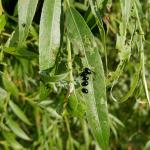
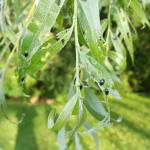 Imported Willow Leaf Beetle: Plagiodera versicolora adult beetles overwinter near susceptible hosts. A few adult imported willow leaf beetles were seen feeding on willow foliage in Chesterfield, MA on 5/11/19 and no mating or egg laying was seen at the time.By 5/22/19, it was very easy to spot adult imported willow leaf beetles feeding and mating, as well as the damage they cause to the leaves. Egg laying was also observed on 5/22/19. On 5/29/19, feeding adult beetles and clusters of eggs were still observed. No larvae were yet seen at this particular location at that time. However, by 6/2/19, clusters of eggs hatched and tiny, feeding imported willow leaf beetle larvae could be seen. These yellowish larvae skeletonize the leaf in groups. Larvae were observed feeding on Japanese pussy willow and corkscrew willow on 6/12/19 in Boylston, MA. Extensive skeletonization of leaves was occurring on the corkscrew willow, in particular, at this location. Larvae are slug-like and bluish-green to yellow in color. They will feed in clusters and skeletonize the leaves. By 7/10/19 in Chesterfield, MA, larvae have pupated and adult imported willow leaf beetles are again present and feeding on willow foliage. Most plants can tolerate the feeding from this insect, and foliage will appear brown. Repeated yearly feeding can be an issue, in which case management of the young larvae may be necessary. Take care with treatment in areas near water.
Imported Willow Leaf Beetle: Plagiodera versicolora adult beetles overwinter near susceptible hosts. A few adult imported willow leaf beetles were seen feeding on willow foliage in Chesterfield, MA on 5/11/19 and no mating or egg laying was seen at the time.By 5/22/19, it was very easy to spot adult imported willow leaf beetles feeding and mating, as well as the damage they cause to the leaves. Egg laying was also observed on 5/22/19. On 5/29/19, feeding adult beetles and clusters of eggs were still observed. No larvae were yet seen at this particular location at that time. However, by 6/2/19, clusters of eggs hatched and tiny, feeding imported willow leaf beetle larvae could be seen. These yellowish larvae skeletonize the leaf in groups. Larvae were observed feeding on Japanese pussy willow and corkscrew willow on 6/12/19 in Boylston, MA. Extensive skeletonization of leaves was occurring on the corkscrew willow, in particular, at this location. Larvae are slug-like and bluish-green to yellow in color. They will feed in clusters and skeletonize the leaves. By 7/10/19 in Chesterfield, MA, larvae have pupated and adult imported willow leaf beetles are again present and feeding on willow foliage. Most plants can tolerate the feeding from this insect, and foliage will appear brown. Repeated yearly feeding can be an issue, in which case management of the young larvae may be necessary. Take care with treatment in areas near water.
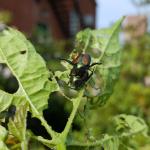
 Japanese Beetles: Popillia japonica adult beetles are active. Adult female beetles will lay their eggs primarily by early August, however eggs may be laid into September. Females lay these eggs in groups in soil cavities they excavate 2-4 inches down. Japanese beetles overwinter as nearly grown grubs in the soil which are capable of evading freezing behaviorally by moving below the frost line. As soils warm in the spring, larvae become active and feed on the roots of grasses. Pupation occurs 1-3 feet below the soil surface. Adults emerge from these lawn areas and disperse to feed on foliage, mate, and return to turf-type locations for females to lay their eggs. Japanese beetle adults use aggregation pheromones (chemicals that signal between individuals) to call in others of the same species. These pheromones and volatile chemicals from host plants being fed upon are thought to be the reason why large numbers of these beetles can be found feeding together. Adult beetles feed on foliage and flowers, often skeletonizing leaves until they appear lace-like. Larvae are highly damaging turf pests. Tree and shrub hosts are comprised of more than 300 species including but not limited to rose, mountain-ash, willow, linden, elm, Japanese and Norway maples, birch, sycamore, rose of Sharon, ornamental apple, and many others. Adult beetles are often attracted to feeding on sunny areas of the plant. Many organisms are parasitoids of Japanese beetles, such as two wasps that attack overwintered grubs in the spring, and a tachinid fly (winsome fly: Istocheta aldrichi) which parasitizes newly emerged adult beetles. Other organisms act as generalist predators with Japanese beetles on their menus, including but not limited to ants, certain other beetles, small mammals, and birds.
Japanese Beetles: Popillia japonica adult beetles are active. Adult female beetles will lay their eggs primarily by early August, however eggs may be laid into September. Females lay these eggs in groups in soil cavities they excavate 2-4 inches down. Japanese beetles overwinter as nearly grown grubs in the soil which are capable of evading freezing behaviorally by moving below the frost line. As soils warm in the spring, larvae become active and feed on the roots of grasses. Pupation occurs 1-3 feet below the soil surface. Adults emerge from these lawn areas and disperse to feed on foliage, mate, and return to turf-type locations for females to lay their eggs. Japanese beetle adults use aggregation pheromones (chemicals that signal between individuals) to call in others of the same species. These pheromones and volatile chemicals from host plants being fed upon are thought to be the reason why large numbers of these beetles can be found feeding together. Adult beetles feed on foliage and flowers, often skeletonizing leaves until they appear lace-like. Larvae are highly damaging turf pests. Tree and shrub hosts are comprised of more than 300 species including but not limited to rose, mountain-ash, willow, linden, elm, Japanese and Norway maples, birch, sycamore, rose of Sharon, ornamental apple, and many others. Adult beetles are often attracted to feeding on sunny areas of the plant. Many organisms are parasitoids of Japanese beetles, such as two wasps that attack overwintered grubs in the spring, and a tachinid fly (winsome fly: Istocheta aldrichi) which parasitizes newly emerged adult beetles. Other organisms act as generalist predators with Japanese beetles on their menus, including but not limited to ants, certain other beetles, small mammals, and birds.
- Lace Bugs: Corythucha spp. and Stephanitis spp. lace bugs are active. Corythucha spp. utilize many hosts such as: hawthorn, cotoneaster, Amelanchier, quince, Pyracantha, various oaks, birch, maple, mountain ash, sycamore, hackberry, elm, walnut, butternut, basswood, etc. Corythucha spp. lace bug eggs (tiny and black) were seen on bur oak on 6/25/2019 in Amherst, MA. Eggs are so small, they may look like fungal spores without magnification. Stephanitis spp. lacebugs such as S. pyriodes can cause severe injury to azalea foliage. S. rhododendri can be common on Rhododendron and mountain laurel. S. takeyai is found on Japanese Andromeda, Leucothoe, Styrax, and willow. Stephanitis spp.lace bug activity should be monitored through September. Certain azalea and Andromeda cultivars may be less preferred by lace bugs.
- Lily Leaf Beetle: Lilioceris lilii adults overwintered in sheltered places. Although adult beetles were not seen during the chilly weather on 5/13/19 in Amherst, MA, previously laid eggs were found on host plant foliage in this location. As of 5/21/19, egg hatch had occurred and larvae of various sizes could be seen feeding on foliage in groups. Smaller larvae skeletonize leaves, whereas larger larvae can eat the entire leaf.By 5/30/19, large lily leaf beetle larvae were observed eating entire leaves. Conditions were also favorable to see adults mating, and eggs could also still be found at this location on 5/30. On 6/3/19, adult lily leaf beetles, eggs, and larvae of various sizes were still seen on host plants. Susceptible hosts include Lilium spp. (Turk’s cap, tiger, Easter, Asiatic, and Oriental lilies) and Fritillaria spp. (Note: daylilies are not hosts.) Typically, in May, mating will occur and each female will begin to lay 250-450 eggs in neat rows on the underside of the foliage. If there are only a few plants in the garden, hand picking and destroying overwintering adults can help reduce local garden-level populations.
- Spotted Lanternfly: (Lycorma delicatula, SLF) is not known to occur in Massachusetts landscapes (no established populations are known in MA at this time). However, officials with the Massachusetts Department of Agricultural Resources (MDAR) urged residents to check plants for spotted lanternfly. On February 21, 2019 MDAR announced the discovery of a single dead spotted lanternfly adult at a private residence in Boston. As a result of this discovery, officials asked the public to check potted plants they purchase and report any suspicious insects. MDAR reports that this particular individual appeared to have been unintentionally transported this past December in a shipment of poinsettia plants originating from Pennsylvania. Officials also report that there is currently no evidence that this pest has become established in MA. For more information about this finding, please visit the MA Department of Agricultural Resources press release:https://www.mass.gov/news/state-agricultural-officials-urge-residents-to-check-plants-for-spotted-lanternfly .
This insect is a member of the Order Hemiptera (true bugs, cicadas, hoppers, aphids, and others) and the Family Fulgoridae, also known as planthoppers. The spotted lanternfly is a non-native species first detected in the United States in Berks County, Pennsylvania and confirmed on September 22, 2014.
The spotted lanternfly is considered native to China, India, and Vietnam. It has been introduced as a non-native insect to South Korea and Japan, prior to its detection in the United States. In South Korea, it is considered invasive and a pest of grapes and peaches. The spotted lanternfly has been reported from over 70 species of plants, including the following: tree of heaven (Ailanthus altissima) (preferred host), apple (Malus spp.), plum, cherry, peach, apricot (Prunus spp.), grape (Vitis spp.), pine (Pinus spp.), pignut hickory (Carya glabra), Sassafras (Sassafras albidum), serviceberry (Amelanchier spp.), slippery elm (Ulmus rubra), tulip poplar (Liriodendron tulipifera), white ash (Fraxinus americana), willow (Salix spp.), American beech (Fagus grandifolia), American linden (Tilia americana), American sycamore (Platanus occidentalis), big-toothed aspen (Populus grandidentata), black birch (Betula lenta), black cherry (Prunus serotina), black gum (Nyssa sylvatica), black walnut (Juglans nigra), dogwood (Cornus spp.), Japanese snowbell (Styrax japonicus), maple (Acer spp.), oak (Quercus spp.), and paper birch (Betula papyrifera).
The adults and immatures of this species damage host plants by feeding on sap from stems, leaves, and the trunks of trees. In the springtime in Pennsylvania (late April - mid-May) nymphs (immatures) are found on smaller plants and vines and new growth of trees and shrubs. Third and fourth instar nymphs migrate to the tree of heaven and are observed feeding on trunks and branches. Trees may be found with sap weeping from the wounds caused by the insect’s feeding. The sugary secretions (excrement) created by this insect may coat the host plant, later leading to the growth of sooty mold. Insects such as wasps, hornets, bees, and ants may also be attracted to the sugary waste created by the lanternflies, or sap weeping from open wounds in the host plant. Host plants have been described as giving off a fermented odor when this insect is present.
Adults are present by the middle of July in Pennsylvania and begin laying eggs by late September and continue laying eggs through late November and even early December in that state. Adults may be found on the trunks of trees such as the tree of heaven or other host plants growing in close proximity to them. Egg masses of this insect are gray in color and, in some ways, look similar to gypsy moth egg masses.
Host plants, bricks, stone, lawn furniture, recreational vehicles, and other smooth surfaces can be inspected for egg masses. Egg masses laid on outdoor residential items such as those listed above may pose the greatest threat for spreading this insect via human aided movement.
For more information about the spotted lanternfly, visit this fact sheet: https://ag.umass.edu/landscape/fact-sheets/spotted-lanternfly .
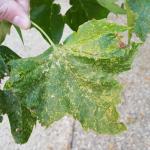 Sycamore Plant Bug: Plagiognathus albatus feeds on the foliage of London planetree and American sycamore in all nymphal stages and as an adult. Using piercing-sucking mouthparts, they pierce young leaf tissue when it is still small. Because this feeding occurs early while leaves are still expanding, the resulting damage in a fully developed leaf may look more severe than when it was initially created by this insect. Leaves may now have a ragged and tattered appearance, despite the fact that most of the damage occurred earlier in the season. Adults of this insect may be present until mid-July. There is one generation per year. Next season, overwintered eggs embedded at the base of leaf buds will hatch by the time foliage is approximately 4 cm. in length. Nymphs may feed from approximately late-May to early June and adults are again present until mid-July. This injury can be mistaken for feeding caused by a leaf beetle also found on sycamore. Sycamore plant bug activity was also reported by Dan Gilrein of Cornell University Cooperative Extension. While the tattered appearance of these leaves may be striking, it is not thought that the damage created by this insect alone causes serious harm to the overall health of the tree.
Sycamore Plant Bug: Plagiognathus albatus feeds on the foliage of London planetree and American sycamore in all nymphal stages and as an adult. Using piercing-sucking mouthparts, they pierce young leaf tissue when it is still small. Because this feeding occurs early while leaves are still expanding, the resulting damage in a fully developed leaf may look more severe than when it was initially created by this insect. Leaves may now have a ragged and tattered appearance, despite the fact that most of the damage occurred earlier in the season. Adults of this insect may be present until mid-July. There is one generation per year. Next season, overwintered eggs embedded at the base of leaf buds will hatch by the time foliage is approximately 4 cm. in length. Nymphs may feed from approximately late-May to early June and adults are again present until mid-July. This injury can be mistaken for feeding caused by a leaf beetle also found on sycamore. Sycamore plant bug activity was also reported by Dan Gilrein of Cornell University Cooperative Extension. While the tattered appearance of these leaves may be striking, it is not thought that the damage created by this insect alone causes serious harm to the overall health of the tree.
- Taxus Mealybug: Dysmicoccus wistariae was spotted on Taxus in Amherst on 5/30/19, 6/3/19, and again on 6/19/19. This insect will produce honeydew which can lead to sooty mold growth, yellowing of needles, and sparsely foliated plants. Eventual dieback may be possible. This species is commonly associated with Taxus in New England, but can be occasionally found on dogwood, Rhododendron, Prunus spp., maple, Andromeda, and crabapple. These mealybugs are found on stems and branches and particularly like to congregate at branch crotches. Management may be targeted between 246-618 GDD’s. Horticultural oil and neem oil may be used according to label instructions.
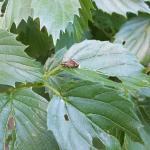
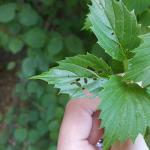 Viburnum Leaf Beetle: Pyrrhalta viburni is a beetle in the family Chrysomelidae that is native to Europe, but was found in Massachusetts in 2004. In Amherst, MA on 6/17/19, plants being monitored for the presence of this pest were devoid of feeding larvae. When observed again on 6/26/19, no larvae or adult Viburnum leaf beetle were seen at this location. This is the time of year that Viburnum leaf beetle larvae, when they are approximately 10-11 mm. long, crawl down the shrub, enter the soil, and pupate. Once this occurs, feeding stops (pauses) until the adult beetles emerge in early July. At that time, adult beetles will resume feeding, mate, and the females will lay their eggs in pits they chew at the ends of twigs. Eggs overwinter. Adults may also migrate to previously not yet infested plants. In Amherst, MA on 7/9/19, adult Viburnum leaf beetles were found mating, feeding, and laying eggs at this location. This beetle feeds exclusively on many different species of Viburnum, which includes, but is not limited to, susceptible plants such as V. dentatum, V. nudum, V. opulus, V. propinquum, and V. rafinesquianum. Larvae may be treated with a product containing spinosad. Some Viburnum have been observed to have varying levels of resistance to this insect, including but not limited to V. bodnantense, V. carlesii, V. davidii, V. plicatum, V. rhytidophyllum, V. setigerum, and V. sieboldii. More information about Viburnum leaf beetle may be found at http://www.hort.cornell.edu/vlb/ .
Viburnum Leaf Beetle: Pyrrhalta viburni is a beetle in the family Chrysomelidae that is native to Europe, but was found in Massachusetts in 2004. In Amherst, MA on 6/17/19, plants being monitored for the presence of this pest were devoid of feeding larvae. When observed again on 6/26/19, no larvae or adult Viburnum leaf beetle were seen at this location. This is the time of year that Viburnum leaf beetle larvae, when they are approximately 10-11 mm. long, crawl down the shrub, enter the soil, and pupate. Once this occurs, feeding stops (pauses) until the adult beetles emerge in early July. At that time, adult beetles will resume feeding, mate, and the females will lay their eggs in pits they chew at the ends of twigs. Eggs overwinter. Adults may also migrate to previously not yet infested plants. In Amherst, MA on 7/9/19, adult Viburnum leaf beetles were found mating, feeding, and laying eggs at this location. This beetle feeds exclusively on many different species of Viburnum, which includes, but is not limited to, susceptible plants such as V. dentatum, V. nudum, V. opulus, V. propinquum, and V. rafinesquianum. Larvae may be treated with a product containing spinosad. Some Viburnum have been observed to have varying levels of resistance to this insect, including but not limited to V. bodnantense, V. carlesii, V. davidii, V. plicatum, V. rhytidophyllum, V. setigerum, and V. sieboldii. More information about Viburnum leaf beetle may be found at http://www.hort.cornell.edu/vlb/ .
Concerned that you may have found an invasive insect or suspicious damage caused by one? Need to report a pest sighting? If so, please visit the Massachusetts Introduced Pests Outreach Project: http://massnrc.org/pests/pestreports.htm .
A note about Tick Awareness: deer ticks (Ixodes scapularis), the American dog tick (Dermacentor variabilis), and the lone star tick (Amblyomma americanum) are all found throughout Massachusetts. Each can carry their own complement of diseases. Anyone working in tick habitats (wood-line areas, forested areas, and landscaped areas with ground cover) should check themselves regularly for ticks while practicing preventative measures. Have a tick and need it tested? Visit the web page of the UMass Laboratory of Medical Zoology (https://www.tickreport.com/ ) and click on the blue Order a TickReport button for more information.
Reported by Tawny Simisky, Extension Entomologist, UMass Extension Landscape, Nursery, & Urban Forestry Program
Additional Resources
To receive immediate notification when the next Landscape Message update is posted, be sure to join our e-mail list and follow us on Facebook and Twitter.
For a complete listing of upcoming events, see our Upcoming Educational Events page.
For commercial growers of greenhouse crops and flowers - Check out UMass Extension's Greenhouse Update website
For professional turf managers - Check out Turf Management Updates
For home gardeners and garden retailers - Check out home lawn and garden resources. UMass Extension also has a Twitter feed that provides timely, daily gardening tips, sunrise and sunset times to home gardeners, see https://twitter.com/UMassGardenClip
Diagnostic Services
A UMass Laboratory Diagnoses Landscape and Turf Problems - The UMass Extension Plant Diagnostic Lab is available to serve commercial landscape contractors, turf managers, arborists, nurseries and other green industry professionals. It provides woody plant and turf disease analysis, woody plant and turf insect identification, turfgrass identification, weed identification, and offers a report of pest management strategies that are research based, economically sound and environmentally appropriate for the situation. Accurate diagnosis for a turf or landscape problem can often eliminate or reduce the need for pesticide use. For sampling procedures, detailed submission instructions and a list of fees, see Plant Diagnostics Laboratory
Soil and Plant Nutrient Testing - The University of Massachusetts Soil and Plant Nutrient Testing Laboratory is located on the campus of The University of Massachusetts at Amherst. Testing services are available to all. The function of the Soil and Plant Nutrient Testing Laboratory is to provide test results and recommendations that lead to the wise and economical use of soils and soil amendments. For complete information, visit the UMass Soil and Plant Nutrient Testing Laboratory web site. Alternatively, call the lab at (413) 545-2311.
Ticks are active at this time! Remember to take appropriate precautions when working and playing outdoors, and conduct daily tick checks. UMass tests ticks for the presence of Lyme disease and other disease pathogens. Learn more.

